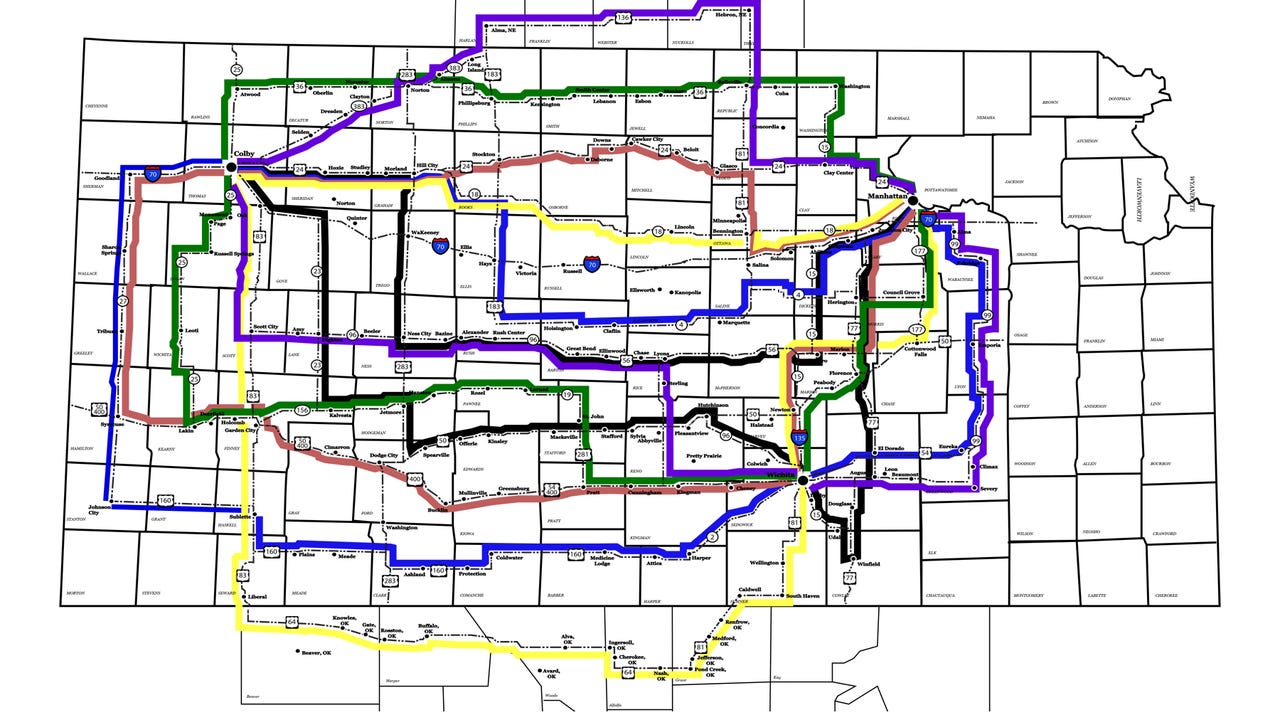The yard sticks and mud boots are packed in the vans, and tomorrow, May 13, the Wheat Quality Council’s 2025 Hard Winter Wheat Tour will set out across Kansas to evaluate the winter wheat crop.
This annual tour of wheat industry professionals, Extension experts and farmers has been a rite of passage in Kansas for 67 years. Participants from all sectors of the grain chain take the opportunity to network and to learn more about the wheat industry. For many, it can be their first time walking into a wheat field.
Van drivers are volunteers with extensive knowledge of wheat. They are often K-State Extension personnel, USDA-National Agriculture Statistics Services employees, Kansas Wheat staff or Kansas wheat farmers. They’re in charge of making stops at random wheat fields along their predetermined routes and taking measurements of the crop’s growth.
The routes begin in Manhattan, Kan., the morning of May 13, driving to Colby, Kan. Then, May 14, the tour will drive from Colby south and east, ending in Wichita, Kan. On May 15, the tour will drive north from Wichita back to Manhattan, where a final tour estimate will be announced. Some routes also drive through neighboring Nebraska and Oklahoma. Representatives of the Nebraska, Colorado and Oklahoma wheat associations also will give updates on their states’ crop progress at the evening meals.
Using USDA-NASS math equations, each carload comes up with an average potential yield for the crop along their route for the day. It’s a snapshot in time, and only measures the potential yield in the field that day.
The USDA-NASS Crop Progress Report of May 5 pegs the Kansas crop at 45% headed, with Oklahoma at 60% headed. The Kansas winter wheat condition, for the week ending May 4, was estimated at 47% good to excellent and 33% fair. In Colorado, 53% of the crop was good to excellent, with 30% fair. The Oklahoma crop was estimated to be 48% good to excellent, with 35% fair. And Nebraska’s wheat crop was estimated to be 33% good to excellent, with 30% fair.

USDA will release its first estimate of the winter wheat harvested acres and total production May 12, just as tour participants are gathering in Manhattan.
But K-State agricultural economist Gregg Ibendahl released his National Winter Wheat Production Outlook for 2025 on May 2. He built a model that uses USDA crop condition reports, planting reports and other data to predict an estimated yield.
Ibendahl’s model predicts:
- Kansas, averaging about 45.8 bushels per acre, harvesting about 6.9 million acres, for a crop of 316 million bushels.
- Colorado, averaging about 36.8 bushels per acre, harvesting about 1.8 million acres, for crop of about 68 million bushels.
- Nebraska, averaging about 41.8 bushels per acre, harvesting about 798,000 acres, for a crop of about 33 million bushels.
- Oklahoma, averaging 34.7 bushels per acre, harvesting about 2.8 million acres, for a crop of about 99 million bushels.
If Ibendahl’s model holds, there is the potential for a 1.2 billion-bushel winter wheat crop from the U.S. in 2025. The Wheat Tour will release its own estimate of potential at noon Thursday, May 15.
Crop conditions expected
Each year, the vans also report on any crop conditions they see in the fields, such as weed pressures, pest pressures, or diseases like wheat rust and wheat streak mosaic. These are shared at the evening meals with further input and context from K-State Extension experts.
This year, the Wheat Tour participants may see a crop that’s barreling toward harvest. In late April, many parts of Kansas had reported the crop was already in the flag leaf growth stage. Rain has fallen across much of the state since mid-April and, combined with cooler temperatures, has resulted in ideal growing conditions for the crop.
However, the increased moisture, just as the flag leaf is emerging, also has Kansas growers concerned about the need for a foliar fungicide application to prevent stripe rust. K-State Extension plant pathologist Kelsey Andersen Onofre reported in the April 24 Agronomy eUpdate that the risk for stripe rust in the state is actually low for 2025. That’s based on unfavorable conditions for rust to develop in Texas, meaning fewer spores to catch a ride on the wind through Oklahoma up to Kansas, she explains.
“Additionally, there have been no reports of stripe rust yet this year in Kansas,” Andersen Onofre writes. “For reference, in years when stripe rust is an issue, we generally detect the disease in Kansas before April 15. With all of this in mind, we believe it will be difficult for stripe rust to establish and ‘catch up’ at this point in the season.”
That doesn’t mean farmers should skip scouting their fields. Andersen Onofre warns that leaf rust could pop up later in the season as the crop reaches heading to flowering stages with warmer temperatures. She’s also advising farmers to prepare for fusarium head blight, or scab. Wheat Tour participants may run across wheat streak mosaic virus this year, as samples from 20 counties across the state have tested positive for the disease. They also may see the sister virus, Triticum mosaic virus, in fields.
Be sure to follow along online at KansasFarmer.com this week as we interview farmers in the field about the crop conditions they’re seeing. And sign up for the daily Kansas Farmer newsletter to catch daily updates from the tour.